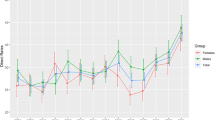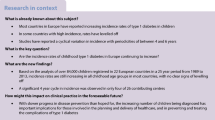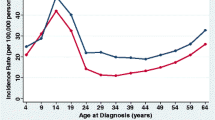Abstract
The Irish Childhood Diabetes National Register (ICDNR) was established in 2008 to define accurately the incidence and monitor the epidemiology of type 1 diabetes (T1D) in the Irish population. Here, we report data from the first 6 years of the National Register and compare with previous national data. Prospective national incident data regarding T1D in those under 15 years resident in Ireland were collected from 2008 to 2013 and national incidence rates (IRs) calculated. Ascertainment completeness was assessed using capture-recapture methodology. The period identified 1566 new cases of T1D, ascertainment reached 96.8 % in 2013. The standardised incidence rate was 27.5 in 2008 stabilising at 28.7 and 28.8 cases /100,000/year in 2012 and 2013. There was no evidence that the incidence changed significantly in the 6-year period either overall or for each age group and gender. There was evidence of a difference in the incidence of T1D across the age groups with the overall incidence highest in the 10–14 year age category. A strong seasonal association was demonstrated.
Conclusions: This study confirms Ireland as a high-incidence country for type 1 diabetes whilst demonstrating that the previous marked increase in IR from 16.3 cases/100,000/year in 1997 has not continued. Ongoing monitoring through the robust mechanism of the ICDNR is required to clarify whether this is a fluctuation or if the incidence of T1D diabetes has stopped rising in our population. Alternatively, this apparent stabilisation may reflect a shift to a later age at diagnosis.
“What is known :” • The incidence of Type 1 diabetes (T1D) is increasing in most populations worldwide although in certain high-incidence populations, it may be stabilising • There was a marked increase in T1D in Ireland between 1997 and 2008 • T1D incidence increases with affluence |
“What is New:” • The high incidence of T1D in Ireland has been confirmed at 28.8 cases/100,000/year in 2013 and has been effectively stable in the period 2008–2013 • Incidence is highest in Irish 10–14 year olds • Changes in incidence possibly reflecting life style and economic climate • Marked seasonality of diagnosis confirmed |



Similar content being viewed by others
Abbreviations
- GDP:
-
Gross domestic product
- ICDNR:
-
The Irish Childhood Diabetes National Register
- IRs:
-
Incidence rates
- PCRS:
-
Primary Care Reimbursement Service
- ROI:
-
Republic of Ireland/Ireland
- SJH/AMNCH:
-
St. James Hospital and the Adelaide and Meath Hospital incorporating the National Children’s Hospital
- T1D:
-
Type 1 diabetes
References
Berhan Y, Waernbaum I, Lind T (2011) Thirty years of prospective nationwide incidence of childhood type 1 diabetes. The accelerating increase by time trends to level off in Sweden. Diabetes 60(2):577–581
Cameron FJ, Amin R, de Beaufort C, Codner E, Acerini CL (2014) ISPAD clinical practice consensus guidelines—2014: diabetes in adolescence. Pediatr Diabetes 15(Suppl. 20):245–256
Cameron FJ, de Beaufort C, Aanstoot HJ, Hoey H, Lange K, Castano L, Mortensen HB, the Hvidoere International Study Group (2013) Lessons from the Hvidoere International Study Group on childhood diabetes: be dogmatic about outcome and flexible in approach. Pediatr Diabetes 14(7):473–480
Daly LE, Bourke GJ, McGilvray, J (1991) Interpretation and use of medical statistics, 4th edn. Blackwell Scientific publications, p 278
DIAMOND Project Group (2006) Incidence and trends of childhood type 1 diabetes worldwide 1990–1999. Diabet Med 23:857–866
Ehehalt S, Dietz K, Willasch AM, Neu A, for the Baden-Württemberg Diabetes Incidence Registry (DIARY) group (2010) Epidemiological perspectives on type 1 diabetes in childhood and adolescence in Germany 20 years of the Baden-Württemberg Diabetes Incidence Registry (DIARY). Diabetes Care 33:338–340
Harjutsalo V, Sund R, Knip M, Groop P (2013) Incidence of type 1 diabetes in Finland. JAMA 310(4):427–428
Haynes A, Bulsara MK, Bower C, Codde JP, Jones TW, Davis EA (2006) Independent effects of socioeconomic status and place of residence on the incidence of childhood type 1 diabetes in Western Australia. Paediaric Diabetes 7:94–100
Haynes A, Bulsara MK, Bower C, Jones TW, Davis EA (2012) Cyclical variation in the incidence of childhood type 1 diabetes in Western Australia (1985–2010. Diabetes Care 35(11):2300–2302
http://www.cso.ie/px/pxeirestat/Statire/SelectVarVal/Define.asp?maintable=NAHO4&Planguage=0, Central Statistics Office Databank accessed 27/10/2015
Kawasaki E, Matsuura N, Eguchi K (2006) Type 1 diabetes in Japan. Diabetologia 49:828–836
LaPorte RE, McCarthy D, Bruno G, Tajima N, Baba S (1993) Counting diabetes in the next millenium application of capture-recapture methodology. Diabetes Care 16:528–535
Patterson CC, Dahlquist GG, Gyurus E, Green A, Soltész G, and the EURODIAB study group (2009) Incidence trends for childhood type 1 diabetes in Europe during 1989–2003 and predicted new cases 2005–2020: a multicentre prospective registration study. Lancet 373:2027–2033
Patterson CC, Dahlquist G, Soltész G, Green A, on behalf of the EURODIAB ACE Study Group (2001) Is childhood-onset type I diabetes a wealth-related disease? An ecological analysis of European incidence rates. Diabetologia 44(Suppl 3):B9–16
Patterson CC, Guariguata L, Dahlquist G, Soltész G, Ogle G, Silink M, IDF Diabetes Atlas (2014) Diabetes in the young—a global view and worldwide estimates of numbers of children with type 1 diabetes. Diabetes Res Clin Pract 103:161–175
Patterson CC, Gyürüs E, Rosenbauer J, Cinek O, Neu A, Schober E, Parslow RC, Joner G, Svensson J, Castell C, Bingley PJ, Schoenle E, Jarosz-Chobot P, Urbonaite B, Rothe U, Krzisnik C, Ionescu-Tirgoviste C, Weets I, Kocova M, Stipancic G, Samardzic M, de Beaufort CE, Green A, Soltesz G, Dahlquist GG (2015) Seasonality variation in month of diagnosis in children with type 1 diabetes registered in 23 European centres during 1989–2008: little short-term influence of sunshine hours or average temperature. Paediatric. Diabetes 16(8):573–580
Patterson CC, Gyürüs E, Rosenbauer J, Cinek O, Neu A, Schober E, Parslow RC, Joner G, Svensson J, Castell C, Bingley PJ, Schoenle E, Jarosz-Chobot P, Urbonaité B, Rothe U, Krzisnik C, Ionescu-Tirgoviste C, Weets I, Kocova M, Stipancic G, Samardzic M, de Beaufort CE, Green A, Dahlquist GG, Soltész G (2012) Trends in childhood type 1 diabetes incidence in Europe during 1989–2008: evidence of non-uniformity over time in rates of increase. Diabetologia 55:2142–2147
Pihoker C, Forsander G, Fantahun B, Virmani A, Luo X, Hallman M, Wolfsdorf J, Maahs DM (2014) The delivery of ambulatory diabetes care to children and adolescents with diabetes. Pediatr Diabetes 15(Suppl. 20):86–101
Rewers MJ, Pillay K, de Beaufort C, Craig ME, Hanas R, Acerini CL, Maahs DM (2014) Assessment and monitoring of glycemic control in children and adolescents with diabetes. Pediatr Diabetes 15(Suppl. 20):102–114
Roche EF (2014) The National Paediatric Diabetes Register and its impact on healthcare. Ir Med J 107(7):197–198
Roche EF, McKenna A, Ryder K, Brennan A, O’Regan M, Hoey HMCV (2014) The incidence of childhood type 1 diabetes in Ireland and the National Childhood Diabetes Register. Ir Med J 107(9):278–281
Roche EF, Menon A, Gill D, Hoey HM (2002) Incidence of type 1 diabetes mellitus in children aged under 15 years in the Republic of Ireland. J Pediatr Endocrinol Metab 15(8):1191–1194
Skrivarhaug T, Stene LC, Drivvoll AK, Strøm H, Joner G, and the Norwegian Childhood Diabetes Study Group (2014) Incidence of type 1 diabetes in Norway among children aged 0–14 years between 1989 and 2012: has the incidence stopped rising? Results from the Norwegian Childhood Diabetes Registry. Diabetologia 57:57–62
Sloka S, Grant M, Newhook LA (2008) Time series analysis of ultraviolet B radiation and type 1 diabetes in Newfoundland. Paediatric. Diabetes 9:81–86
Svensson J, Carstensen B, Mølbak AG, Molbak A, Christau B, Mortensen HB, Nerup J, Borch-Johnsen K (2002) The Danish study group of diabetes in childhood. Increased risk of childhood type 1 diabetes in children born after 1985. Diabetes Care 25:2197–2201
Tuomilehto J (2013) The emerging global epidemic of type 1 diabetes. Curr Diab Rep 13:795–804
White NH, Cleary PA, Dahms W, Goldstein D, Malone J, Tamborlane WV, Diabetes Control and Complications Trial (DCCT)/Epidemiology of Diabetes Interventions and Complications (EDIC) Research Group (2001) Beneficial effects of intensive therapy of diabetes during adolescence: outcomes after the conclusion of the diabetes control and complications trial (DCCT). J Pediatr 139:804–812
WHO Multinational Project for Childhood Diabetes (Diabetes Mondiale) (1991) Diamond study, method of operations, version 2, Parts I-IV
Zhao Z, Sun C, Wang C, Li P, Wang W, Ye J, Gu X, Wang X, Shen S, Zhi D, Lu Z, Ye R, Cheng R, Xi L, Li X, Zheng Z, Zhang M, Luo F (2014) Rapidly rising incidence of childhood type 1 diabetes in Chinese population: epidemiology in Shanghai during 1997–2011. Acta Diabetol 51(6):947–953
Acknowledgments
We are grateful to the Primary Care Reimbursement Services (PCRS) for their assistance, Mr. B. Carr ICT Tallaght Hospital and Professor J Grimson, University of Dublin, Trinity College Dublin and HIQA, for their advice and support in the development of the ICDNR.
We are particularly grateful to all the participating centres, paediatric endocrinologists, paediatricians, parents and children with type 1 diabetes.
Authors’ contributions
E.R. conceived the project, wrote the manuscript and researched data. A.McK. researched data and reviewed/edited the manuscript. K.R. reviewed/edited the manuscript. A.B. reviewed/edited the manuscript. M.O’R. researched data and reviewed/edited the manuscript. H.H. contributed to the discussion and reviewed/edited the manuscript. E.R. is the guarantor for this paper.
Author information
Authors and Affiliations
Corresponding author
Ethics declarations
Funding
This study and the Irish Childhood Diabetes National Register was funded a grant from the National Children’s Hospital Foundation Ireland since its inception.
Conflict of interest
The authors declare that they have no competing interests. The authors do not have a financial relationship with the National Children’s Hospital Foundation who sponsored this study.
Ethical approval
All procedures performed in studies involving human participants were in accordance with the ethical standards of the institutional and/or national research committee and with the 1964 Helsinki declaration and its later amendments. Ethical approval for the ICDNR was granted by the SJH/AMNCH Joint Research Ethics Committee in accordance with the Declaration of Helsinki.
Informed consent
Written informed consent was obtained from all individual participants included in the National Diabetes Register.
Additional information
Communicated by Beat Steinmann
Rights and permissions
About this article
Cite this article
Roche, E.F., McKenna, A.M., Ryder, K.J. et al. Is the incidence of type 1 diabetes in children and adolescents stabilising? The first 6 years of a National Register. Eur J Pediatr 175, 1913–1919 (2016). https://doi.org/10.1007/s00431-016-2787-6
Received:
Revised:
Accepted:
Published:
Issue Date:
DOI: https://doi.org/10.1007/s00431-016-2787-6




